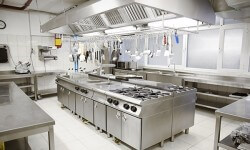Restaurants require so many things, great chefs, food prep staff, sous chefs, customers, wait staff, and a fully functional kitchen, including commercial plumbing. Restaurants represent an environment that needs an excellent water supply, adequate drainage, proper ventilation, and energy-efficient appliances. Read on to learn about 5 Reasons Proper Commercial Plumbing is Essential to Restaurants!
Read more →Ideally, renovations will result in an improved space. However, with so many details to consider, some might be too easy to overlook. HVAC design is one of these details. Renovating a building or even just a single office can go wrong if HVAC design is not taken into account.
Read more →Office distractions are terrible for productivity. While open office spaces are great for promoting employee comradery and cubicles still offer some modicum of privacy, they also allow for plenty of noise to disturb important work. HVAC noise might seem trivial, but it’s one of the more distracting and troublesome sounds that can plague a workspace and should therefore be taken seriously. So what can you do to reduce HVAC noise?
Read more →Restaurants consume significantly more electricity than many other types of businesses. According to recent data, restaurants use about 38 kilowatt-hours (kWH) per square foot of enclosed space. The majority of energy use is linked to processes such as Heating water, Refrigeration, Cooking, or Cooling and heating the building. Having a higher-than-average utility bill comes with the territory of owning a restaurant. The good news is that there are ways that you can reduce your establishment’s electric consumption and your monthly utility bill. One of the best tactics involves upgrading to an efficient HVAC system. On that note, join us as we outline what is the most efficient HVAC system for restaurants. If your system is wasting energy or you are simply ready for an upgrade, this guide’s for you.
Read more →Anyone who owns a commercial building knows that ductwork is an integral part of the property’s operations. In order to operate at maximum efficiency, your HVAC ductwork needs to be designed, sized, and installed correctly. Proper duct size is all too often an overlooked feature of commercial HVAC systems. The role that duct sizing and material play in maintaining a safe, comfortable environment should not be underestimated. Having the right size and material for your ducts will maintain comfortable conditions, improve indoor air quality, minimize energy losses, and lower your heating and cooling bills, as well.
Read more →As we move into summer, more and more businesses are reopening. This is happening across the country. For this article, we are paying particular focus on Maryland, and Washington D.C. However, as more states are looking to reopen, this applies to any commercial business. As COVID-19 restrictions are lifted, people will be returning to work and customers to businesses. So, before you do that, what are the important HVAC systems to check before reopening?
Read more →When it comes to commercial restaurant HVAC, restaurant owners cannot be too complacent. They cannot risk forgoing preventative maintenance service for their HVAC systems, and always need to make sure it’s in good, working order.
Read more →When it’s time to replace or install an HVAC system in your building, there are several options to consider. One of those options is called an RTU HVAC system. It still provides heating and cooling, along with the same air quality benefits as any HVAC system. What makes an RTU system different, however, is its location and setup. Here’s what you need to know about RTU HVAC systems and how to tell if it’s the right choice for you.
Read more →Refrigerant recovery is outlined in the US Environment Protection Agency due to the extremely hazardous nature of the refrigerants and coolants. Each step and procedure should pass standards and safety benchmarks in accordance with proper disposal, reclamation, and retrieval. Here is a list of the types of refrigerant recovery methods and disposal methods.
Read more →The requirements for a restaurant HVAC far exceed those of a typical non-food prep commercial building. A traditional HVAC system utilizes a two-part process. To put it simply, the system pulls in outdoor air into the building through a make-up air unit. The air is then conditioned […]
Read more →









